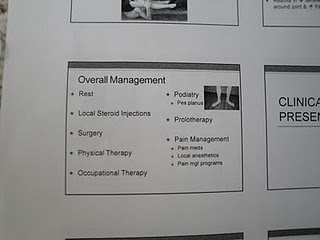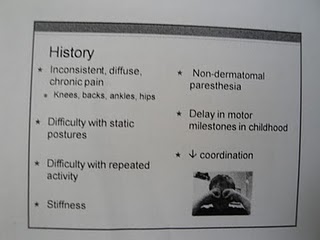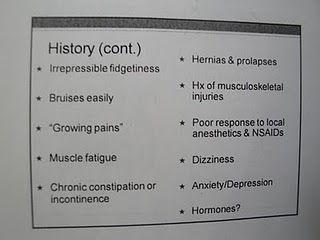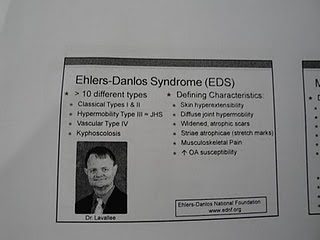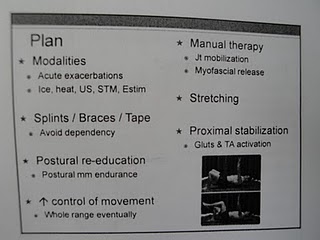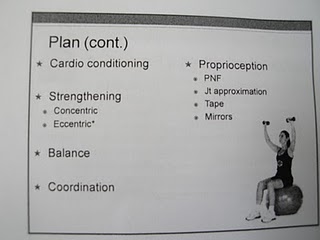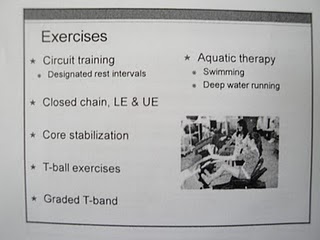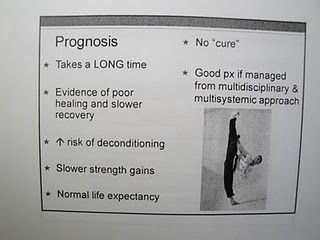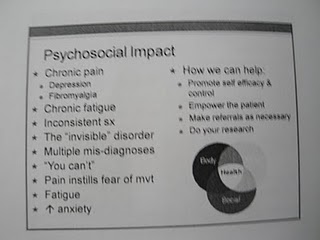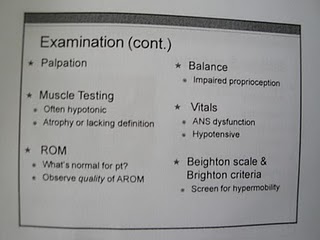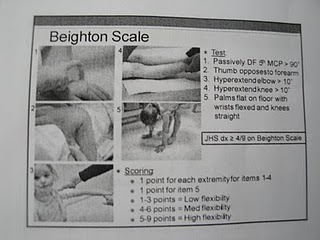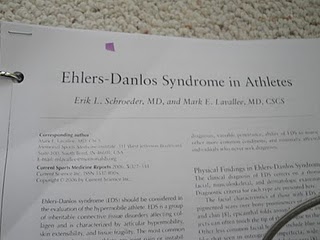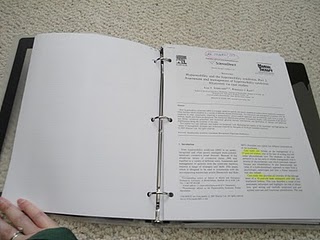EDS Inservice
Last Tuesday, was the Ehlers Danlos Inservice that the PT student who I have been working closely with put together for all of the other therapists. She had asked me to come to show the Beighton Scale (one of the ways I was diagnosed), and to help answer questions and provide information from a patient’s perspective. ?I was so proud of her~She put so much work into the presentation. It is always surprising to me how little is known about EDS in the medical world. This is why I was extremely THANKFUL to this student who took the time to educate the therapists, to help “make the invisible, visible,” and hopefully help other patients get to a proper diagnosis in a much more timely fashion than it took me.
The slides below are from her PowerPoint. Let me be clear~this is NOT my presentation. I did not put together these slides. The PT student did, and she was nice enough to share these and all of her other resources with me.
I wanted to include these for educational purposes. Each day, my blogger stats say I have about 100 readers and I can’t help but think that there may be other EDSers out there reading that may benefit from more information. I know I STILL look for blogs to help me better understand both EDS and POTS.
I was asked a lot of questions at the end of the presentation. Some about prolotherapy, some about POTS, some about my journey to my diagnosis, some about my prognosis and where I am at in my therapy right now. One therapist asked me if I felt like I have made any improvements since I started therapy.. I said well, when I started, I was in a wheelchair most of the time, and now I am able to do therapy for over an hour.” It was interesting to see people’s surprised, wide eyes when I said this….
But the question that stood out to me the most was, “What would you want all of us therapists to know about EDS?” This was a loaded one. There was so much I wanted to say. Because I get nervous speaking in front of a lot of adults, I honestly do not remember everything I said, but I remember I said these things…(and remember, I can only speak for ME)
-
That people with EDS are not just circus freaks who can pull skin over their head and contort their bodies in a million different ways (which I am learning is the mainstream medical perception of people with EDS). It is a spectrum.
-
That someone can look completely normal, and fine and be struggling with the pain and other complications that come with EDS. That it is invisible!
-
That the pain is inconsistent and travels!
-
That my EDS manifested first with GI problems, which does make sense to EDS experts since the whole GI tract is connective tissue, but is not something that is usually recognized as a part of EDS by non-EDS medical specialists.
-
That if the therapists have a patient with extreme hypermobility, who is complaining of dizziness, body heaviness, and/or weakness, that they should recommend that the patient have a tilt table test or other autonomic nervous system tests to confirm or rule out a POTS diagnosis (or other forms of Dysautonomia). I explained that I have learned that Dysautonomia and EDS often go together like PB and J.
-
That neck instability, POTS and fatigue are the worst complications of EDS for me. Even though they may see me at therapy doing the elliptical for 10 minutes, I may be flat on my back the rest of the day from extreme fatigue, or I may feel okay. It just depends on the day.
-
That days are inconsistent! Some days I feel like a normal person and other days I am back in my wheelchair, feeling sick, dizzy, and weak.
-
That therapy exercises work best for me when I alternate body parts and alternate sitting and standing positions.
-
That neck traction is too much for me!
-
That certain exercises I do at therapy feel like they are screwdrivers, that are tightening my joints.
-
That my period makes my joints feel more lax.
-
That EDS is an emotional roller coaster and it is so important to listen to the patient because each day is different.
-
That if they suspect EDS, the patient should be seen by a Geneticist.
-
That ginger root sometimes helps my pain.
-
That pacing is a (difficult) goal of mine that I am working on to learn how to do things I need to do to get to the end of the day still feeling okay.
-
To tell their patient’s to keep a daily journal to try and find triggers and patterns for good days and bad days.
The PT student also taught me a lot and reiterated things I have learned along the way. Because Brad had a snow day that day, he came and listened too. As we were leaving he noted that I seemed pretty happy. I said, “I am! I was TEACHING again!” It felt so purposeful and rewarding to be able to educate others again….and it made me miss my kids that much more!
I am so appreciative to the awesome PT student who included me and gave me the chance to give EDS a patient’s voice in a room of medical professionals. Maybe, just maybe, something that the student or I said will help another EDSer along the way.
*If you click on each picture, you can see them better.
My management so far includes all but surgery (knock on wood), occupational therapy, and podiatry.
All are true for me except the last two. I think gymnastics helped with these.?
All are true for me except growing pains. As far as hernias go, one of the EDS doctors believes a lot of my GI problems are due to Hiatal Hernias because my stomach is most likely hypermobile as well.
I am a type 2. And that’s my doc! The amazing Dr. Lavallee who has type 1!
I do not do much stretching anymore since I am already too stretchy. But all the others are part of my plan.
I am working on all of these! I am working more towards cardio. This is the hardest because of my POTS.
Most of my program right now is circuit training and core stabilization.
I am working towards more low intensity aerobics. I do some hand weights and pelvic floor exercises.
Must keep that in mind. Must dig deep and find my patience~”Takes a LONG time.”
Energy conservation, pacing, joint care, an activity log, regular exercises, and orthostatic management are the biggies for me right now.
Enough said.
NOTE: ANS dysfunction includes POTS and other types of Dysautonomia
Beighton Scale: Hypermobility Test. I scored 9/9.
The PT student gave me all her resources! So nice.
My new book of EDS resources.
Tags: Dysautonomia, Ehlers-Danlos, Physical Therapy, POTS, Relationships

